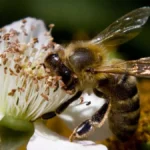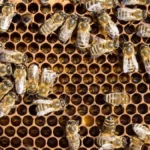Economics Of Honey
Bees collect nectar and pollen from flowers, propolis from plant resin, chewing gum and other sticky sources, and water from wet places. They will also collect insect sugar secretions and sometimes fungal spores. Bees also collect human sugar waste from rubbish bins and waste sites. These external inputs provide a source of energy and nutrients for the hive. Bees will use more resources if they have more resources. Much like any creature, abundance leads to prosperity, and somewhat ironically, prosperity eventually leads to failure. If you want to manage your bees, or your humans correctly as well, it is important to manage the failure out of the system. In this regard, beekeeping can teach us a lot about human economics.Do Apiaries Experience Kondratief Waves?
When I was a student and started keeping bees I had a wise old Prof. who loved to talk about Kondratiev waves. He was also a surfer, and he told us “Learn to surf Kondratiev waves.” One of his friends was a teacher who taught Elon Musk, and I suspect that this teacher may have taught Mr. Musk that lesson, which explains why he is such an exceptional businessman. Kondratiev waves are widely accepted by businessfolks as being a useful model to predict economic opportunities – and are not accepted by a lot of academics – this is understandable because people who make money, and talk about it are quite different. A Kondratiev wave generally started during a period of economic collapse. Some bright spark comes up with a technology that makes life more efficient and more productive – this then causes economic growth for clever people who capitalize on the technology. With time idiots, pundits, politicians, unions, middle management, and other potentially saprophytic members of society then manage the new technology into a state of despair and the economy collapses, the fools lose their power, and clever people are allowed to invent a new solution in a new field and the cycle repeats itself. Bees are simple mechanical beasts – their efficiency is governed by their ability to convert sugar to energy. This in turn is governed by the enzyme malate dehydrogenase which governs the ability to generate motion and heat with their wing muscles. Drones with good malate dehydrogenase will be able to fly fast and catch queens. Queens that mate with good drones produces good workers that are efficient, and good workers produce a lot of honey, and this produces strong hives. Strong hives produce a lot of drones, and these drones are exposed to more competition to catch queens. This in turn results in better bees and better beehives. With time, beekeepers manage their hives to produce more honey. They become complacent that their bees are “good” and then start doing silly things like removing drone brood to increase honey production. Subsequent generations of queens then have to go out and mate with whatever drones they can find, the quality of the wing muscles in the bees declines, hive efficiency collapses, and we hit the bottom of a curve. A while later, the beekeeper cannot justify managing the hives as much, because the honey yields are low. The hives get a bit neglected, the beekeeper stops removing drone brood and mysteriously the situation corrects itself and a few years later we hit the top of a cycle again and then mismanage it into the ground.How Does All Of This Apply To Brood Boxes?
Let us refer to one hive in our apiary as hive A and the others as Hives B. Hive A has workers, a queen, and drones that each provide services. These are all produced in the brood box. The queen lays eggs. The workers tend to the eggs and rear both new workers and new drones. Workers maintain the hive, and drones provide genetics for other hives in the apiary. Other hives in the apiary provide drones for hive A as well. So with drones sharing is caring. As our beehives expand, they produce more workers. If the queen mothers were able to fly to a well-populated drone congregation area, and, really fly hard to tire the drones out, and then chose the best and fastest drones, the queens can produce efficient workers. These workers in turn produce an efficient hive and apiary efficiency increases. If we look at this improvement in efficiency as our bees and our apiary adapt to the location they are in, we find we can increase the number of brood boxes. This in turn increases the worker population of the hive. If you have abundant nectar resources, this in turn results in increased honey production. If you do not have abundant nectar resources, you may end up with a decline in honey production and an increase in bee production. This is where management, observation, and experience come into play. We need to ask “How many brood boxes should a hive have?”How Many Brood Boxes Should A Hive Have?
In spring and early summer when hives are building rapidly you can often let the bees move into two brood boxes. This will help to increase the number of bees that you have and also increase the risk of swarming. To manage the risk of swarming, you can requeen the hives, cause the hives to rear new queens, or split them. This also depends on the genetics of the hive. This article describes the difference in brood rearing and swarming between Russian and Italian bees.Also read: How Many Bees Are In A Hive Box? Beekeeping Explained
If you requeen a hive and allow it to have a double brood box brood nest, you will end up with a lot of bees. This will depend on the race of bees you choose, with some bees building up faster than others. If you expand a hive population too much you can end up with a situation where the queen produces insufficient pheromone to control the workers in the supers furthest away from the brood nest, and these will begin to lay drone brood in your supers. There is consequently a certain amount of management common sense that goes into managing large beehives.
If You Are A Beginner What Brood Box Configuration Works Best?
In most parts of the world, you will not have problems if you use a single brood box, a queen excluder, and two to three shallow supers above this. In spring, if you find that the bees are expanding a lot, and you have a hive that is really full of bees, you can always add a second brood box and then split this to make another hive. I have had mixed results with large double brood box hives. The problem with large hives is that they burn the queens out quickly – if she is laying a lot of eggs every day, and the hive gets really huge, the queen gets tired. You have exceptional queens that can manage this for a while, but they do always get tired. In my experience, I have generally found that with double brood box brood nests, the bees expand up into the second super during spring and early summer. They then retreat down into the first brood box and fill the second brood box with honey. However, sometimes, you get these crazy hives that just maintain a huge brood nest and also rear a lot of drones. When you have a few of these hives, the entire productivity of the apiary seems to improve over a few years. But this is hard work, and I have got lazy, and just prefer to go with what works. A brood box, a queen excluder, two supers, and a lot less admin. The bees figure it out, and they seem to remain productive. By limiting your brood nest size, you also encourage the bees to focus a bit more on honey production – in this regard my opinion is divided – in some areas, a queen excluder and a single brood box produce more honey, and in other areas, a double brood box and no queen excluder produce more honey! It is a case of experiment and seeing what works for out. It also helps to chat with some old-timer beekeepers in your area. And remember to take the “In the summer of 1971 I harvested 15 supers” of one hive story with a pinch of salt. In summary, when asked “How many brood boxes should a hive have?” I typically would suggest for a beginner, start with a simple brood box, queen excluder, and one to two supers configuration. As you gain experience, ask other beekeepers in your area what has really worked for them. Experiment with double brood boxes, double brood boxes with an excluder, and doubles without an excluder, and see what works for you. See if building up an apiaries genetics (allow some drone rearing, and don’t buy queens in) improves your hive efficiency. Experiment as much as possible. That is to be human. If you enjoyed this please share. Read more about: When To Add A Second Brood BoxFAQs
[rank_math_rich_snippet id=”s-04c20199-e4b9-411d-b7af-2ce39d9b8123″]
Dr. Garth A. Cambray is a Canadian/South African entrepreneur and beekeeper with 28 years of experience in apiculture and specializes in adding value to honey. His Ph.D. research developed a new advanced continuous fermentation method for making mead that has resulted in a number of companies globally being able to access markets for mead. His company, Makana Meadery, exports honey mead to the USA where it is available to discerning connoisseurs. He has also developed technologies to commercially manufacture organic honey vinegar in Zambia for export globally. He holds a few patents globally in the ethanol industry and believes in technology and knowledge transfer for human development and environmental sustainability. One of his proudest achievements is the fact that the wind farm he started at one of his old apiary sites has essentially made his hometown carbon neutral.






